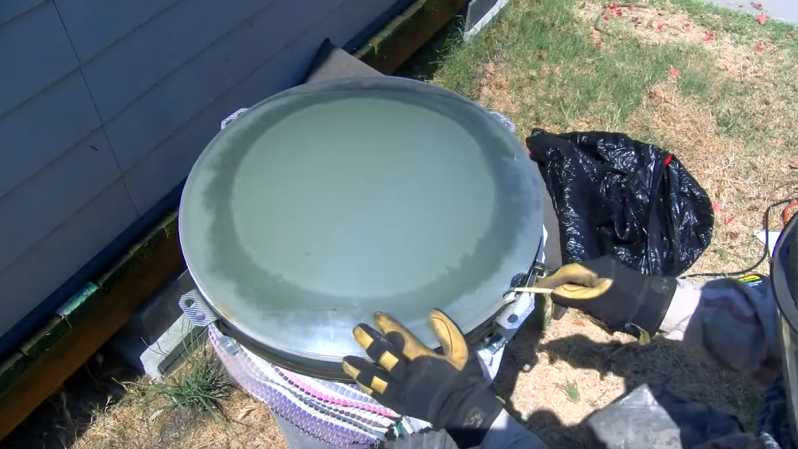It’s been a long time since the family TV has had a CRT in it, and even longer since that it was using what was basically an overgrown oscilloscope tube. But “roundies” were once a thing, and even back in the early 80s you’d still find them in living rooms on TV repair calls, usually sporting a characteristic and unsightly bullseye discoloration.
Fast-forward a few decades, and roundy TVs have become collectible enough that curing their CRT cataracts is necessary for restorationists like [shango066], a skill he demonstrates in the video below. The defect comes from the composite construction of CRTs — a safety feature added by television manufacturers wisely concerned with the safety aspects of putting a particle accelerator with the twin hazards of high vacuum and high voltage in the family home. The phosphor-covered face of the tube was covered by a secondary glass cover, often tinted and frosted to improve the admittedly marginal viewing experience. This cover was often glued in place with an epoxy resin that eventually oxidized from the edges in, making the bullseye pattern.
The remedy for this problem? According to [shango066], it’s heat, and plenty of it. After liberating the tube from the remarkably clean TV chassis, he took advantage of a warm summer’s day and got the tube face cooking under a black plastic wrap. Once things were warmed up, more heat was added to really soften the glue; you can easily see the softening progress across the face of the tube in the video below. Once softened, gentle prying with wooden chopsticks completes the job of freeing the safety lens, also in remarkably good shape.
With the adhesive peeled off in an oddly satisfying manner, all that’s left is a thorough cleaning and gluing the lens back on with a little silicone sealant around the edges. We’d love to see the restored TV in operation, but that’s left to a promised future video. In the meantime, please enjoy a look at the retro necessities TV owners depended on in the good old days, which really weren’t all that good when you get down to it.
















I’ve done 2 of them now, a Zenith and an RCA, and the resulting image, though not HD, is certainly watchable. I think it’s great that Shango and others (including me) have an interest in seeing young folks take an interest in this vintage tube technology.
whenever I see someone doing this it gives me the creepies, what could go wrong heating up a very old large tube and then prying at it
Uhhh nothing? They’re not bashing it with clubs like a caveman, they’re methodically restoring a piece of equipment.
It’ll be fine
And in the worst case, the tube will not explode. It will implode but not send shrapnels very far.
I appreciate the sharing of knowledge, but I noticed that most videos with interesting subjects are so poorly filmed and edited. this one was 22 minutes long. half of it was “one handed fail while shoving your face close up”
it even included a small rant about the price of Windex!
It’s shango, that’s why we watch :)
That’s typical of his videos, he really knows his stuff when it comes to old TVs (and old Soviet radios it seems) but he does have his own style, take it or leave it.
I’m not talking about him in particular, but about the hundreds of youtubers with the same style.
The part where he heated up the screen with the hot air gun could have been sped up 16x or just cut short. No need to show us literally the whole process. “I KNOW, I know, I got it… i got the concept”
I recorded a few youtube videos and I’m not saying mine are any better. But I review them before rendering and i realize how boring they are, how much I’m ranting inadvertently, and start trimming all that fat. I’ve had many cases where I removed more than half of my video.
That is youtube though, isn’t it? Anyone can upload a video, and not all of them really know how to make a good video.
Those are resurrection lilies that just sprung up late July or August for a week or two, fitting as a color tube gets a resurrection. I fixed up one of those roundies and brought color TV into my parents basement before we got color in the living room. Then I sold it for $100. That was a big chunk of my tuition at Purdue.
I did this on an HP2644A terminal’s CRT years ago. Even then, the wide rectangular screen was unobtainable new. I built a wooden box to hold the tube/glass shrapnel vertically, and used a nichrome wire powered to some heat level below red hot but above touchable via +12v from an old AT power supply to do the cutting of the RTV-like rubber. After cleaning, I replaced the shield with a thin bead of aquarium grade RTV around the perimeter of the CRT face and outside of the bezel mask. Just like new, and no burn marks on the tube either.
I would not use these tubes without an implosion shield under any circumstances. Apparently when they implode, they eject the neck, including the electron gun that breaks off the socket, out the front and towards your face!